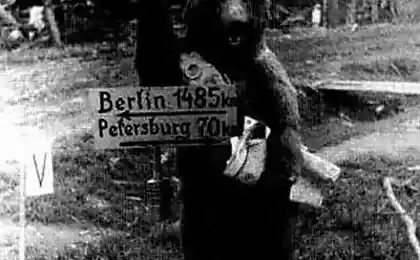855
Story about Andriusha
Looking around the exhibits in the Central Museum of the Armed Forces, came across this exhibit, and long tried to figure out what kind of animal.

Unfortunately, a photo was not, so I spread a photo of Museum in Togliatti. Only in Togliatti costs already postwar copy Andriusha based on ZIL-157. Originally mounted on the chassis of their Studebaker

as it turned out, a further development of the legendary Katyusha BM-31 - BM-31-12, firing 300mm shells. This machine entered service in June 1944. If Katyusha rockets had guides in the form of rails, then we see Andrei's volumetric framework of pipes, representing a rectangle, which are inscribed in 12 circles, is a guide to the shells. It is necessary to replace this honeycomb structure on the package of pipes, and we get a modern rzso type "Tornado»
Projectile "Andrei's" power, more than 2 times superior munition "Katyusha", and was able to destroy any wood-earthworks. Even in reinforced concrete fortifications the Germans could not feel safe when fired M-30 and M-31, a direct hit on such a shelter, leads to massive concussion refuge. were also earlier variants of this system in a steady embodiment, without use of the chassis when the package together with the rails installed on the ground shells. This option is called an M-30 and went down in history as a flying barn. All of this design comes packed in a box. To the system of enclosed instructions, but, as is often the case, the latter embarks on roll-ups before reading. As a result, the initial phase of combat employment of the M-30, together with shells in the sky and rushed the package itself. Given the size of the box, is not difficult to imagine the reaction of the German soldiers on the first volleys "Andrew." From the report of the German non-commissioned officer, "These Russian quite insolent, they have now sheds shoot!" But it is not only a lack of experience and failure to follow instructions led to the emergence of a mysterious weapon. Often, during the battle was simply no time for the necessary preparations. Yes and combat characteristics such extraordinary method of application disrupted rather positively. This salvo has a strong psychological effect - the Germans simply fled, leaving their positions, seeing as they fly a huge 3-meter box. Yes, and gets a more powerful explosion, due to the cumulative effect and the unspent fuel.
Posted in [mergetime] 1414264824 [/ mergetime]
Simplicity of design and ease of operation, and allowed the mass in the shortest possible time to provide "Andrew" army. In military successes Nevel, Smolensk, and other operations of the Red Army, Autumn 1943, have a considerable contribution unduly neglected "Andrew." A setting Andriusha on chassis that will improve mobility and reduce the risk of retaliation, made RZSO Andrew truly formidable weapon.

Unfortunately, a photo was not, so I spread a photo of Museum in Togliatti. Only in Togliatti costs already postwar copy Andriusha based on ZIL-157. Originally mounted on the chassis of their Studebaker

as it turned out, a further development of the legendary Katyusha BM-31 - BM-31-12, firing 300mm shells. This machine entered service in June 1944. If Katyusha rockets had guides in the form of rails, then we see Andrei's volumetric framework of pipes, representing a rectangle, which are inscribed in 12 circles, is a guide to the shells. It is necessary to replace this honeycomb structure on the package of pipes, and we get a modern rzso type "Tornado»
Projectile "Andrei's" power, more than 2 times superior munition "Katyusha", and was able to destroy any wood-earthworks. Even in reinforced concrete fortifications the Germans could not feel safe when fired M-30 and M-31, a direct hit on such a shelter, leads to massive concussion refuge. were also earlier variants of this system in a steady embodiment, without use of the chassis when the package together with the rails installed on the ground shells. This option is called an M-30 and went down in history as a flying barn. All of this design comes packed in a box. To the system of enclosed instructions, but, as is often the case, the latter embarks on roll-ups before reading. As a result, the initial phase of combat employment of the M-30, together with shells in the sky and rushed the package itself. Given the size of the box, is not difficult to imagine the reaction of the German soldiers on the first volleys "Andrew." From the report of the German non-commissioned officer, "These Russian quite insolent, they have now sheds shoot!" But it is not only a lack of experience and failure to follow instructions led to the emergence of a mysterious weapon. Often, during the battle was simply no time for the necessary preparations. Yes and combat characteristics such extraordinary method of application disrupted rather positively. This salvo has a strong psychological effect - the Germans simply fled, leaving their positions, seeing as they fly a huge 3-meter box. Yes, and gets a more powerful explosion, due to the cumulative effect and the unspent fuel.
Posted in [mergetime] 1414264824 [/ mergetime]
Simplicity of design and ease of operation, and allowed the mass in the shortest possible time to provide "Andrew" army. In military successes Nevel, Smolensk, and other operations of the Red Army, Autumn 1943, have a considerable contribution unduly neglected "Andrew." A setting Andriusha on chassis that will improve mobility and reduce the risk of retaliation, made RZSO Andrew truly formidable weapon.






















